 |
|

|
 |
TABLE of CONTENTS
 |
National Work Zone Awareness Week highlights safety during construction season |
By Sue Roe
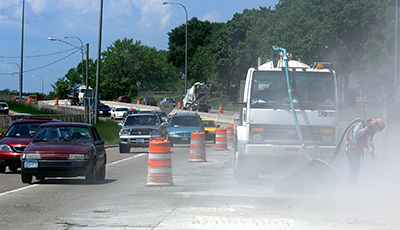
A worker stands close to traffic while working in a work zone as traffic speeds by him. About 200 work zones will pop up across the state this construction season. Photo by David Gonzalez |
MnDOT is observing National Work Zone Awareness Week this week as a way to encourage safe driving through highway work zones.
The week is an annual spring campaign to coincide with the start of road construction season. MnDOT will officially kick off the construction season April 13, although many construction projects are already underway.
Theme for the week is “Work Zone Safety is in Your Hands,” reinforcing the messages that motorists constantly should be alert and prepared for unexpected changes in and around work zones.
More than 200 active work zones are scheduled throughout the state this construction season. A work zone is defined as any area where highway construction, maintenance or utility work is being done. Work zones are identified by warning signs, signals, barriers, pavement markings and flaggers.
Over the past five years in Minnesota, an average of seven people died in work zone crashes and 753 fatal or serious injury crashes occurred.
In 2015, the last year data is available, there were nine fatal crashes, resulting in 10 fatalities and 519 injury crashes. Thirty-one MnDOT employees were among those injured.
“Drivers and passengers are more likely to be killed in work zones than workers, but maintenance and construction crew workers have also lost their lives, been injured or had close calls,” said Jay Hietpas, state traffic engineer. “Rear-end crashes are the most common type of work zone crash. Most of these crashes occur because of driver inattention and speeding, both behaviors we can change.”
Hietpas said MnDOT works to alert motorists in work zones and sets speeds that are safe for navigating through it. He said when entering work zones, motorists should obey the posted speed limits, pay attention to signs and flaggers, be patient and not drive distracted.
“These work zones exist because we’re making roads better and safer. We’re asking that people look for work zones, slow down and put down their cellphones and other distractions,” Hietpas said. “The 511mn.org website is a good resource to check for road closures, detours and traffic incidents.”
MnDOT offers a Work Zone Safety Awareness Program for the public and work zone safety and traffic control classes, including flagger training, for employees.
The National Work Zone Awareness Week observance is in cooperation with the American Association of State Highway and Transportation Officials, the Federal Highway Administration and the American Traffic Safety Services Foundation. |
 |
|

|
 |
TABLE of CONTENTS
 |
Agency kicks off asset management state of practice assessment |
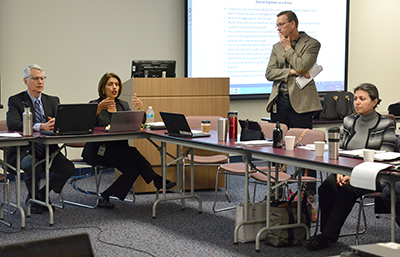
From left, asset management consultants Gordon Proctor and Shobna Varma lead a group from the Operations Division to help evaluate its asset management practices. Also participating in the discussion are Dave Solsrud, asset management project manager, and Nastaran Saadatmand, Federal Highway Administration. Photo by Rich Kemp |
Would it be cheaper to spend money to paint the siding on a home periodically, or wait until its life is used up and then replace it?
In making that decision, homeowners would need to consider many factors, including costs over time, the performance of the asset along the way, knowing how fast deterioration will progress under various maintenance strategies or options, and their ability to make investments now or in the future.
MnDOT has an effort underway that’s evaluating its asset management practices (e.g., financial management, planning, maintenance) on its own assets (e.g., pavements, bridges, drainage structures, etc).
Last week about 100 agency experts participated in one or more of 11 meetings over three days to help provide a solid understanding of the agency’s asset management practices.
“Asset management requires a coordinated effort by so many of us at MnDOT,” said Dave Solsrud, who is leading the asset management effort.
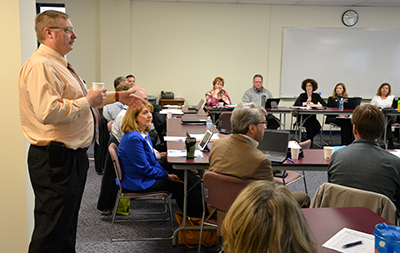
Standing, Mike Barnes, Operations Division assistant commissioner, talks about asset management with the district engineers and other members of his division, at the interview session held March 30. Photo by Rich Kemp |
Using a grant from the Federal Highway Administration, MnDOT over next several months will evaluate how it performs asset management activities against the best practices nationally. The outcome will be a plan to improve processes in areas that will have the greatest positive effect on the department. Asset management consultants Gordon Proctor and Shobna Varma will help MnDOT evaluate its practices.
“MnDOT is nationally recognized for some of its asset management practices,” Solsrud said. “This work will help us find the best places to focus our efforts to refine and improve processes and the benefits we provide to our public.”
MnDOT stakeholder groups interviewed during the meetings represented:
- Strategic leadership for asset management
- Financial planning and management
- Planning and programming functions
- Pavement, bridge, drainage, traffic infrastructure functions
- Operations leadership
- Maintenance functions
- TAMS (Transportation Asset Management System) and other management systems
- Data governance
“Needs continue to increase faster than funding and our program increasingly focuses on asset preservation,” said Mark Gieseke, Transportation System Management director, who participated in one of the sessions. “Asset management has become the foundation for planning and programming highway projects. Growing our asset management capabilities to a wider range of asset types will help us to wisely stretch our construction dollars.”
According to the American Association of State Highway Transportation Officials, and the Federal Highway Administration, asset management is a systematic and strategic approach to managing transportation infrastructure assets. It relies heavily on using accurate data to plan for the long-term maintenance of assets at the lowest “life cycle” cost. It couples engineering decisions with forecasts of the length of time assets will last, and seeks to incorporate future maintenance cost implications through economic and financial analyses’.
Solsrud said good asset management depends on a broad range of elements coming together:
- Knowing what we have – inventories and condition information
- Knowing what options we have to engineer fixes and maintenance
- Having guidance/policies in place to guide planning an decision making
- Having information systems available to assess investment strategy outcomes across the state
- Having processes in place to coordinate decision making between planning, engineering, and maintenance
- Having processes in place to maintain the quality of the data such as when construction work is performed, or inspections are completed
Next steps in MnDOT’s effort include preparing a survey to further explore key issues and findings, followed by a series of workshops concluding mid-summer.
“We really appreciate interview participants for taking the time to provide us with their perspectives on asset management,” Solsrud said. “It’s valuable information for us as we move forward with this effort.” |
 |
|

|
 |
TABLE of CONTENTS
 |
MnROAD facilities will undergo construction this year |
|
By Bob Filipczak, Office of Materials and Road Research
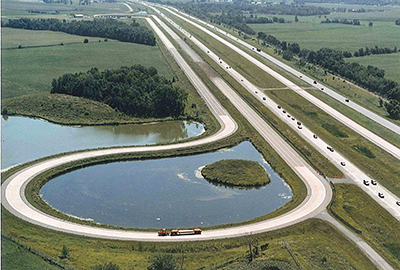
All three sections of MnROAD’s roadway will have new test cells installed this summer. This aerial view shows the low volume loop. File photo |
Even though MnROAD is one of the biggest and most sophisticated pavement research facilities in North America, the construction program for 2017 is a pretty big deal.
First off, the scope is larger than in previous years. MnROAD does research on three different sections of road: the high-volume original Interstate 94 westbound (built in 1973), the mainline I-94 westbound (originally opened in 1994) and the low-volume road closed track. All three roads will be having test cells installed this year, which speaks to the size of this year’s construction.
This is also the first season that has National Road Research Alliance-sponsored test cells—experiments requested by alliance members and funded through the combined pool of money created by the alliance. In terms of “tangible benefits” for members in the NRRA, this is the big one. MnDOT will be providing the 2.5 million of construction funding from it's state road construction funding.
The bid letting date for this year’s construction is April 28, but the plans were made available for contractors on March 31. This should give the projects more exposure and generate more interest. Construction begins June 5 and continues until November 2017.
Forensic analysis of failed cells
Before any construction starts this year, each test section that is being reconstructed will receive a final forensic study. This allows researchers a look at each layer to see the distress that has occurred over the years—and make the final analysis of why it failed. There are always a lot of theories on the causes of what actually failed, but until the forensic is performed, there isn’t proof on what happened. These findings will help build longer lasting pavements in the future.
Studies and test cells to watch
HMA overlay and rehab of concrete and methods of enhancing compaction - States are looking for longer lasting HMA overlays of concrete. New mix designs were developed to promote long-term performance, including how reflective cracking effects can be minimized through design or other joint treatment.
Cold central plant recycling - Other states have used reclaimed asphalt pavement stockpiles into plant mix base course mixes (layers below the wear surface) to effectively recycle these materials in a controlled mix design. How can these layers best be used and what type of surface mix or chip seal can be placed on top?
Fiber reinforced concrete pavements - Nationally, states want to get a better understanding of the beneficial use of fibers in concrete pavement layers. Is it worth the cost? How can it be best used in both thin city streets and higher volume roadways? Can it be used in new construction and in concrete overlays? The research will provide the answers.
Long-term effects of diamond grinding - Each state has aggregates that have been used in concrete pavements that are considered reactive aggregates. Questions arise as to whether diamond grinding might accelerate deterioration in these pavements. What types of topical sealers can be used to treat the surface after the diamond grinding will also be tested.
Early opening strength to traffic - What effect does heavy traffic loading have on the long-term performance of full-depth concrete pavement, as well as fast–setting repairs? Test sections will be loaded by a pickup truck in one lane early enough to produce shallow ruts in the surface. In the other lane, a loaded 18-wheeler will travel over the new concrete immediately after it sets, and then sequentially every six hours up to 30 hours. The long-term effects of these early loadings will then be evaluated.
Optimizing the mix components for contractors - What effect do low-cementitious content mixes have on long-term performance and constructability of concrete pavements? Two low cementitious content mixes will be studied to give agencies a better understanding of cost savings. Can these savings be achieved without significantly affecting long-term performance?
Compacted concrete pavement for local streets - Compacted concrete pavement is a form of roller compacted concrete that has a standard concrete pavement surface texture. The RCC industry has been successful in Michigan and Kansas constructing CCP pavement on local streets. This research will determine if the texture that is accomplished is durable in harsh freeze-thaw climates.
Recycled aggregates in aggregate base and larger subbase materials - States continue to look for effective ways to recycle materials into unbound bases. This research will add to MnROAD’s understanding of recycled bases and what seasonal strength values can be used for advanced mechanistic designs--and how they are affected by size/gradation.
Maintaining poor pavements - Road owners continually have less funding to maintain their roadway systems. What practices should be used for stabilizing both hot mix asphalt and Portland cement concrete roadways when longer-term repairs cannot be done due to funding levels?
Partial depth repair of concrete pavements - Agencies continually seek improved materials and methods for the repair of concrete pavements. In this study, up to 15 innovative concrete pavement repair materials will be evaluated on the concrete panels of the westbound I-94 bypass parallel to the MnROAD mainline.
Thin overlays--Experimenting with very thin overlays could provide a real benefit for a lot the roads currently out there. The premise is that with thin overlays, the ride can be smoother and the life of older roads can be extended.
“We don’t often get to reconstruct random roads these days, and when we do, we have much better specifications for low temperature cracking. By the same token, we have to maintain all those older roads built before we had performance grade binders,” said Dave Van Deusen, Materials and Road Research Lab principal engineer. “We will be doing this makeover on an original section of MnROAD built back in the 90’s.”
In one experiment, there is a head-to-head comparison of thin overlays on two sections of road. One section has a thick base and subbase under the asphalt. The other has a heavy asphalt top with very little base.
Van Deusen says if they can get an extra five years of life out of road using thin overlays, he would be pleased. Often, he admits, he is surprised by how long these “short-term” fixes actually last. |
 |
|

|
 |
TABLE of CONTENTS
 |
Pairing advancing equity with improving intentional customer engagement provides success stories |
By Judy Jacobs
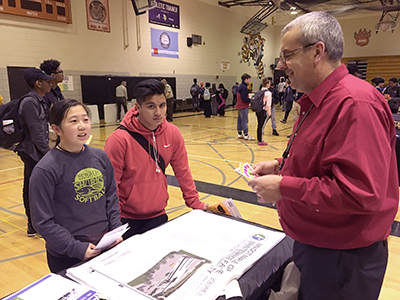
Mike Ligday, Building Services Section Data analyst, talks to two Minneapolis South students at the school's career fair on March 21. Photo by Chris Moates |
Transportation is about people: the public the agency serves, the agency staff, interagency colleagues and all potential partners and communities. In 2016, MnDOT Senior Leadership selected the two priority areas of WIG 2.0: Earning Customer Trust: (1) advancing equity and (2) improving intentional customer engagement.
These priorities were chosen based on feedback from the diverse public, indicating a need to shift the efforts to more of a customer mindset. These two WIG 2.0 priorities relate to each other on many levels. If one is done well, success is likely in the other area too.
Advancing equity means actively searching for opportunities for people of color, women, people with disabilities and the economically or socially disadvantaged. It also means MnDOT provides products and services to serve the diverse communities across the state, with the customers’ outcomes in mind.
Eric Davis, chief of staff, and Betsy Parker, chief counsel, are co-champions of the advancing equity priority area.
“When we can demonstrate to our diverse communities across the state that we are committed to meeting their needs, only then will we know we have successfully achieved customer trust in the areas of providing equal opportunities in contracting and employment,” said Davis.
One attempt to reach out and generate interest in jobs at MnDOT is currently under way with the Building Services employees at Central Office. Their sub-WIG is to actively recruit diverse students for future employment at MnDOT. Team members are visiting local high school job fairs and sharing information about MnDOT with students.
“The students we’ve talked to so far have been really interested in what MnDOT has to offer. Many of the students don’t realize we offer employment opportunities outside of road construction and maintenance,” said Chris Moates, Building Services Section supervisor. “This is a great example of how individuals and workgroups can have a direct impact and contribute to this Wildly Important Goal.”
Nicole Bartelt, Science, Technology, Engineering and Math education and outreach coordinator, is sharing MnDOT’s STEM program with students at local schools.
“Our goal is to provide high-quality activities and initiatives to help promote science, technology, engineering and mathematics to students in kindergarten through high school,” Bartelt said. “The interest in the program has been very encouraging.”
In pairing intentional customer engagement with advancing equity, Mitch Rasmussen, assistant commissioner of the State Aid Division and co-champion of the priority area of intentional customer engagement priority area, said, “Intentional customer engagement is a shift in our mindset and our actions from ‘pushing our products’ to engaging all of our customers to provide comprehensive solutions that focus on their needs and concerns.”
The Interstate 94/Minneapolis to Brooklyn Center project team hosted an open house for all interested vendors and job applicants. A business opportunity flier called, “Opportunity Knocks” was designed to encourage women, minorities and veteran-owned businesses to attend the open house and register to be on MnDOT’s vendor list. MnDOT staff were available to assist interested vendors with the application process.
“We really want to work with local residents and business owners in the communities where the reconstruction of I-94 is taking place,” said David Aeikens, Metro District communications and engagement. “This job and vendor fair gives us a great opportunity to reach out to communities we may not have actively solicited job applicants and vendors.”
As Tracy Hatch, deputy commissioner, chief financial officer and chief operating officer, said in a recent WIG 2.0 report out, “WIG 2.0 is the power of 5,000 MnDOT employees all working together to make our agency more diverse, more inclusive and more engaging to balance the needs of all Minnesotans and achieve the best possible outcomes.” |
 |
|

|
 |
TABLE of CONTENTS
 |
Survey aims to improve customer email experience |
“It was a very timely response, better than I expected considering MnDOT must receive many (inquiries) from a lot of disgruntled people.” - MnDOT customer survey response
The Office of Public Engagement and Constituent Services recently launched a new post-contact customer survey as part of the agency’s shift toward becoming a truly customer centric organization.
The survey, launched at the beginning of March, is aimed at customers who have submitted emails to MnDOT either via the public website or directly to the Customer Relations inbox (info.dot@state.mn.us). The survey is pushed out biweekly to capture customer feedback from constituents whose inquiries were responded to by MnDOT staff and have files marked as “closed” within the previous two weeks. A copy of the survey can be found here.
Customers are asked to share with MnDOT the nature of their inquiry, if the response time met their expectations, how well the response addressed their question or concern, and whether their experience would lead them to contact the agency in the future with a question, comment or concern. Check out complete data from the first round of customer surveys.
“This customer survey effort aligns directly with WIG 2.0 and is further evidence of the organization’s commitment to improving intentional customer engagement,” said Richard Davis, director, Office of Public Engagement and Constituent Services, and champion of the WIG 2.0 Goal Area: Improve External Customer Experience.
“The sub-WIG team behind this effort found that in 2016, 61 percent of customer responses were completed within three business days; by the end of 2017, we want that number to be 80 percent on time,” he said.
The Customer Response Management program is a statewide effort involving Central Office and District staff at all levels, including office directors, administrative assistants, project managers, planners and public affairs coordinators. Laurel Janisch coordinates the program under the leadership of Jeanne Aamodt, customer relations manager, with support from Renee Raduenz, market research manager, .
For more information, visit the Customer Response Management site. |
 |
|

|
 |
TABLE of CONTENTS
 |
MnDOT staff play role in shaping future of AASHTO |
By Rich Kemp
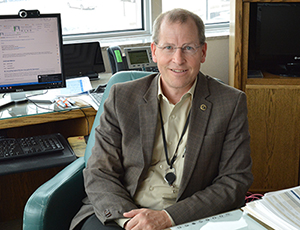
Tim Henkel, assistant commissioner for modal planning and program management, served on an ASSHTO steering panel to review the organization's committee structure and operations. Photo by Rich Kemp |
The American Association of State Highway and Transportation Officials is going through a reorganization of the AASHTO committee structure. The reorganization was developed over the last 18 months by a committee review steering panel, comprised of senior state DOT officials.
Tim Henkel, assistant commissioner for modal planning and program management, served on the committee that made the recommendations for the changes.
“The committee’s recommendations were approved by AASHTO Board of Directors at their fall meeting," said Henkel. "The plan approved by the board achieves numerous objectives through both structural and operating changes to AASHTO committees, including improving nimbleness, expediting committee decision-making, and increasing multi-modal communication and collaboration."
Under the old structure, Commissioner Charlie Zelle is a member of the Board of Directors and chairs the standing committee on public transportation. Under the new structure the commissioner remains a member of the Board of Directors; his role in the new public transportation council, a part of the new Transportation Policy Forum, will be confirmed in the coming months. The new public transportation council provides input on policy issues to the forum and will discuss and recommend policy positions to the Board of Directors, to address multimodal, multi-disciplinary, and emerging issues, in coordination with all of the councils.
“It is an opportunity for states to work together, share best practices and lessons learned,” said Zelle. “With my experience in the bus industry, the standing committee on public transportation was a perfect fit. The committee develops legislative, policy and program recommendations related to all forms of public transportation services.”
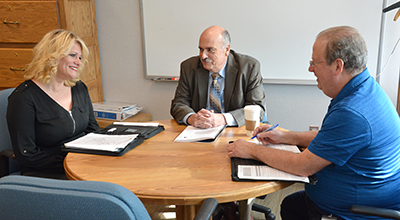
Dan Kahnke (center), MnDOT’s Audit director, speaks with Lisamarie Stroschein, internal audit manager, and Greg Hlivka, external audit manager. Photo by Rich Kemp |
Dan Kahnke, MnDOT’s Audit director, is the chair of the AASHTO committee on internal and external audit.
“We meet once a year to discuss audit issues in states and new regulations,” said Kahnke. “We have a very active committee. One of the policies we put into place was to have the home state of a consultant do the audit of them and have other states accept it. It cuts down on the number of audits.”
The transition and restructuring process will be phased in over multiple years. A new strategic management committee was established to guide the process.
For more than 100 years, AASHTO has depended on the involvement and support of its member state DOT volunteers. Additional comprehensive committee review materials, including a list of steering committee members, timelines, and important documents, can be found on the committee web site.
The roles and responsibilities of AASHTO’s committees vary depending on the needs of the state DOTs related to the subject matter involved, but typically include one or more of the following:
- Policy development and interpretation
- Development and maintenance of technical standards and specifications
- Production of guidance and manuals
- Provision of services to the state DOTs
- Dissemination of information
- Professional development and collaboration/sharing of expertise
“AASHTO’s products and services have significantly contributed to the successful accomplishment of MnDOT’s mission," said Henkel. “With the re-organization of AASHTO comes the opportunity for MnDOT to also review its role, involvement, and investment in AASHTO committees, professional development, and technical services. Nancy Daubenberger, Engineering Services Division assistant commissioner, and I plan to bring together MnDOT interests to recommend a path forward.” |
 |
|

|
 |
TABLE of CONTENTS
 |
Ten employees graduate from Emerging Leaders Institute |

MnDOT had 10 employees graduate from the Emerging Leaders Institute March 17. The ELI is a cohort-based leadership development program designed to prepare future leaders in Minnesota state government. Graduates included from left in first row: Molly McCartney, Metro District planning program coordinator; Kristin White, Chief Counsel; Calahena Merrick, Human Resources; Sandra Martinez, State Aid Finance, Arie Herfindahl, District 8 Systems Analysis. Back row, from left: Sulmaan Khan, Federal Aid; Katie Caskey, Transportation System Management; Joan Maxwell, Metro District Human Resources; Susan Larson, Metro District Finance, and Jessica Etukudo, Human Resources. Photo by Pat Bursaw |
|
 |
|
| |
|



